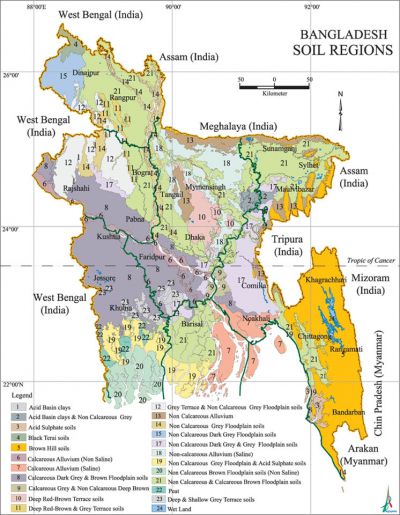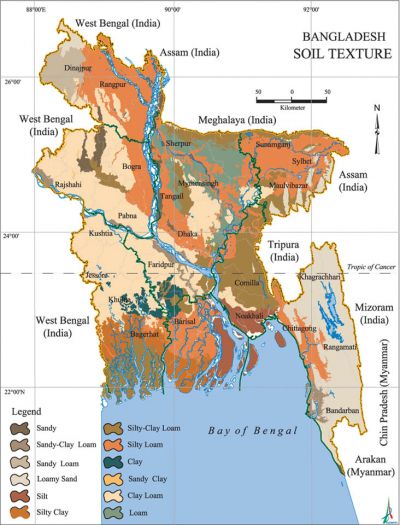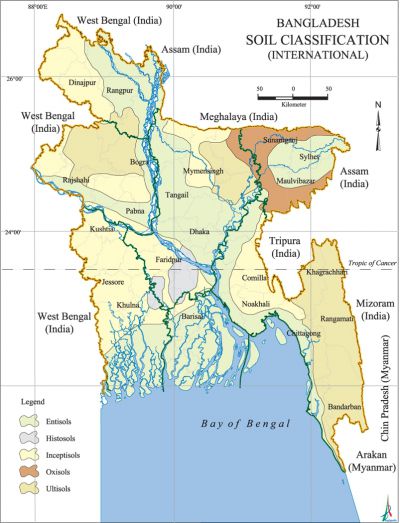Bangladesh Soil
Bangladesh Soil The major part of Bangladesh is on the delta formed by the three major rivers brahmaputra, ganges and meghna. These rivers and many of the country's other minor rivers originate outside the national boundary of the country and make up the Ganges-Brahmaputra-Meghna river system.
The system drains a basin of some 1.76 million sq km and carry not only snowmelt water from the himalayas but also runoff water from some of the highest rainfall areas of the world. Over millennia, the sediments carried by the huge discharges of these rivers have built a broad delta, forming most of the large area of Bangladesh and the submerged delta-plain in the bay of bengal. These huge sediments are the major sources of formation of 80% soils of the country. The remaining 20% of soils have been formed in Tertiary and Quaternary sediments of hills (12%) and in uplifted pleistocene terrace (8%).
Soil formation Regarding soil formation, two distinct conditions occur in Bangladesh: alternating seasonal wet or inundated and dry conditions, as prevalent on most of the floodplain areas, and intermittently wet or moist or dry conditions, as on the upland areas of hills and terraces. This is due to variation of agroclimatic parameters in different seasons. The soil formation process differs significantly between floodplain, hill and uplifted terrace.
Floodplain In many areas, the soil surveys recognised active, young, and old floodplain landscapes. Active floodplains occupy land within and adjacent to the main rivers where shifting channels deposit and erode new sediments during the annual floods. Newly deposited alluvium within this floodplain is stratified in different layers. Usually, silty and clay deposits are finely stratified, and sandy deposits, as well as mixed sandy and silty deposits are coarsely stratified. This is a state from where the soil forming factors are yet to activate the soil forming processes.
The young and old floodplains are virtually stable land that the main river channel has moved away, but they are crossed by tributary or distributary channels that vary from active to moribund delta. On these floodplains, the process of soil formation dominates over sediment deposition, as evidenced by soil characteristics ie the original alluvial stratification has been broken up by biological mixing; the subsoil has developed structure and oxidised mottles; and, in older soils, the topsoil has become acid.

Hill Soil forming processes are active on the hills for a significant period. Due to erosion on steep slopes of high hills, the weathered material on the hills is constantly removed and thus keeps the soils young on the high hills. The soils on the low hills are older as erosion is less severe and allows soil material to accumulate. The sedimentary rocks underlying steep to very steep high hill ranges are usually hard and relatively rich in weatherable minerals and lower hills are unconsolidated and poor in weatherable minerals. Soils have been developed from these minerals through prolonged weathering under well to excessively drained conditions, leaching, acidification and removal of surface material by erosion. There is an increase of clay content from surface to subsoil indicating clay illuviation in most of the soils formed in the low hills.
Pleistocene Terrace Unlike other floodplain terraces, the madhupur clay was uplifted and formed a terrace above sea level probably before the Late Pleistocene. Since then it has been subject to the action of soil forming processes. Soils have been developed in the two kinds of Madhupur clay - deeply weathered pervious clay and little altered impervious clay. They vary considerably in drainage, depth of solum and degree of profile development, depending on the extent of weathering of the parent material and the topography.
Soil classification The soil resources development institute (SRDI) has identified about 500 soil series in Bangladesh. Soil series is a group of soils formed from the same kind of parent material under similar conditions of drainage, vegetation, climate and time, and having the same sequence of soil horizons with similar differentiating properties. Each soil series is known after a name of locality (eg Tejgaon series, Sara series, Ishwardi series, etc). This is the starting point of soil classification in Bangladesh for creating a platform for its correlation with international soil classification systems (FAO or USDA - United States Department of Agriculture). All of these soil series have been mapped as soil association by the SRDI through reconnaissance soil survey carried out during 1965 and 1975. These soil series have been correlated with the FAO-UNESCO soil units of Fluvisols, Gleysols, Histosols, Planosols, Luvisols, Cambisols and Arenosols. According to the' USDA soil taxonomy, these soil series are Entisols, Inceptisols, Histosols, Mollisols, Ultisols and Alfisols.

The international soil classification terms include three elements: i) the primary unit (eg Gleysol, Fluvisol), equivalent to a soil order or plant family; ii) the soil unit (eg Eutric Fluvisol, Dystric Fluvisol), which is a major subdivision of a primary unit, roughly equivalent to a suborder or a plant genus; and iii) the sub-unit (eg Orthi-Eutric Fluvisol, Chromi- Eutric Fluvisol), which provides for inter-grades between two primary units or two soil units, and is roughly equivalent to a subgroup or plant species.
Soils are classified at these different levels of classification according to the presence or absence of what are termed diagnostic horizons and diagnostic properties. Major diagnostic horizons of soils of Bangladesh are Cambic B, Argillic B, Calcic B or C, Histic H, Mollic A, Ochric A, Umbric A, Fluvic, Fimic A. According to these diagnostic properties, the 500 soil series identified by SRDI have been classified in the revised FAO-UNESCO soil map legend (FAO/UNDP, 1986).
This international soil classification is very important to the soil scientists at national and international levels. The benefit of the advancement of soil resources in any part of the world could easily be translated or harvested through the understanding of this international classification. But this classification is highly technical for the common users in the field of agriculture. In order to simplify the technical soil classification of Bangladesh for the common users, a total of 21 general soil types have been recognised.
General soil type A non-technical grouping of soils, made originally to enable non-specialists to make use of the technical information provided by the FAO/UNDP Soil Survey Project in the 1960s. These general soil types give a very broad level of generalisation of soil characteristics. Each general soil type includes several kinds of soil series, developed in more than one kind of parent materials and may include a wide range of chemical and physical properties. The objective of this classification is to classify together soils with broadly similar characteristics so as to provide an overview of soil conditions of a whole country or a region.
Floodplain soils They are divided into different sub-types, such as - calcareous alluvium, non-calcareous alluvium, calcareous brown floodplain soils, calcareous grey floodplain soils, calcareous dark grey floodplain soils, non calcareous grey floodplain soils, non calcareous brown floodplain soils, non calcareous dark grey floodplain soils, black terai soils, acid basin clays, acid sulphate soils, peat, grey piedmont soils, made-land.
Table General soil types of Bangladesh.
| General soil type | Area (ha) | (%) |
| Floodplain soils | 9,718,722 | 78.96 |
| Calcareous Alluvium | 591,796 | 4.81 |
| Non-calcareous Alluvium | 562,242 | 4.57 |
| Calcareous Brown Floodplain soils | 478,518 | 3.89 |
| Calcareous Grey Floodplain soils | 170,767 | 1.39 |
| Calcareous Dark Grey Floodplain soils | 1,434,678 | 11.66 |
| Non Calcareous Grey Floodplain soils | 3,387,153 | 27.52 |
| Non Calcareous Brown Floodplain soils | 383,312 | 3.11 |
| Non Calcareous Dark Grey Floodplain soils | 1,599,645 | 13.00 |
| Black Terai soils | 83,408 | 0.68 |
| Acid Basin clays | 348,994 | 2.84 |
| Acid Sulphate soils | 226,647 | 1.84 |
| Peat | 130,005 | 1.06 |
| Grey Piedmont Soils | 215,279 | 1.75 |
| Made-land | 106,278 | 0.86 |
| Hill soils (Brown Hill Soils) | 1,561,472 | 12.69 |
| Terrace soils | 1,028,030 | 8.35 |
| Shallow Red-Brown Terrace soils | 72,549 | 0.59 |
| Deep Red-Brown Terrace soils | 189,380 | 1.54 |
| Brown Mottled Terrace soils | 34,235 | 0.28 |
| Shallow Grey Terrace soils | 265,427 | 2.16 |
| Deep Grey Terrace soils | 352,152 | 2.86 |
| Grey Valley soils | 114,287 | 0.93 |
| Total soil area | 12,308,224 | 100.00 |
Source FAO/UNDP, 1988.
Calcareous Alluvium Soils are stratified or raw alluvium throughout or below the cultivated layer. They are calcareous throughout or part of it and lack in having diagnostic subsoil horizon. This alluvium on the active Ganges floodplain mainly comprises brownish grey to pale brown sandy and silty deposits, which are moderately calcareous. Soils on the Lower Meghna estuarine floodplain are slightly calcareous grey to olive, finely stratified silts. They are mainly Calcaric Fluvisols.
Table General soil types of Bangladesh.
Non-calcareous Alluvium Similar to calcareous alluvium, except they are non-calcareous in soil profiles. These soils occupy extensive areas on the active Tista and Brahmaputra-Jamuna floodplains. They are sandy or silty, grey or olive, neutral to slightly alkaline. Most of these soils have been included as Eutric Fluvisols.
Calcareous Brown Floodplain soils They have cambic B-horizon that is predominantly oxidised, containing lime in the profiles. They comprise pale brown to olive brown, friable, loamy and clay soils occurring on the upper parts of ridges on the Ganges river floodplain and on the river bank of the Ganges tidal floodplain. Most of these soils belong to Calcaric Gleysols.
Calcareous Grey Floodplain soils They have grey matrix cambic B-horizon and lime in the profiles. They range from silt loam and silty clay loam on riverbanks and floodplain ridges to silty clays in basins. Soils of this group mainly occur on the Ganges tidal floodplain in the southwest, also minor areas on the river floodplain of the Ganges and Lower Meghna. They are Calcaric Gleysols.
Calcareous Dark Grey Floodplain soils Occur extensively on the Ganges floodplain and locally on the soils that comprise cambic B-horizon and lime in part or throughout the solum and with a dark grey topsoil and/or upper subsoil. There are continuous dark grey gleans as well in the Ganges tidal floodplain. They are Calcaric Gleysols.
Non-calcareous Grey Floodplain soils Generally comprise a grey topsoil and a cambic B-horizon in the subsoil with a grey matrix or grey gleans. They extensively occupy Tista, Karatoya-Bangali, Jamuna, middle Meghna and eastern Surma-Kushiyara floodplains. However, there are considerable regional differences in the proportions occupied by individual soil textures. Silt loam texture is dominant in the Tista meander floodplain whereas silty clays are predominant in the Ganges tidal floodplain and in the Surma-Kushiyara floodplain. But the Jamuna floodplain has a more even distribution of silt loam, silty clay loam and silty clays. Most of these soils have been included in Eutric Gleysols.
Non-calcareous Dark Grey Floodplain soils They have a cambic B-horizon, non-calcareous dark grey topsoil and subsoil. They occur extensively on the Old Brahmaputra and old Meghna estuarine floodplain. Silt loam and silty clay loam are predominant on the Meghna estuarine floodplain and in the Tista meander floodplain, whereas silty clays and heavy clays are extensive on the Old Brahmaputra floodplain. The majority of these soils are Eutric Gleysols.

Non-calcareous Brown Floodplain soils Occur largely on the Old Himalayan Piedmont Plain, mostly on the ridges. They also occupy minor areas in the Tista, Karatoya-Bangali, Jamuna and Old Brahmaputra floodplains, and in some western parts of the Ganges floodplain. These soils are non-calcareous and having Cambic B-horizon which is fully or predominantly oxidised. There are two kinds of soils in this group. One class belongs to deep soils with dark coloured topsoil, occurring extensively on the Old Himalayan Piedmont Plains. Another class is mainly shallow soils, lacking thick dark coloured topsoil occurring mainly outside the Old Himalayan Piedmont Plain. Most of these soils are Dystric/Eutric Gleysols or Cambisols.
Black Terai soils Occupy the Old Himalayan Piedmont Plain. These soils have very dark grey or black topsoil at a thickness of 25 cm or more. When the dark coloured topsoil is less than 90 cm thick, it is underlain by a well-oxidised cambic B-horizon. This topsoil is either mollic or umbric horizon. The texture of these soils ranges from loamy sands on the highest ridge sites to sandy loams and sandy clay loams over most of the landscape. They are either Umbric or Mollic Gleysols.
Acid Basin clays Occupy basin sites in some old floodplain landscapes, mainly in the eastern-Kushiyara floodplain, Sylhet Basin and its piedmont basins. They also occur in the deep valleys of madhupur tract. The soils are grey to dark grey, heavy clays and strongly acidic. It has a strong prismatic and blocky structure, grey or dark grey gleans on ped faces. These soils are Eutric, Dystric or Mollic Gleysols.
Acid Sulphate soils Occur predominantly on the Chittagong coastal plain and in minor areas of the Ganges tidal floodplain. These soils contain sulphidic material, which turns extremely acid if exposed to air. The soils, which are under Mangrove Forest and flooded by saline tidal water are finely stratified soft muddy sediments. But where it has been embanked to prevent flooding with saline water, the soils of these areas have developed profiles similar to non-calcareous grey and dark grey floodplain soils with extremely acidic horizon. They are either Thionic Fluvisols or Thionic Gleysols.
Peat Occurs extensively in the Gopalganj-Khulna Beels and locally in some haors of the Sylhet Basin. The soils contain organic matter at the surface or buried under a mineral soil layer below at a depth of up to 40 cm. The organic material that forms the Histic horizon varies from dark brown, fibrous peat to semi-liquid black muck. They have been included as Histosols.
Grey Piedmont soils Occur extensively on the northern and eastern Piedmont Plains and locally on the Chittagong coastal plain. They have been formed in the out-wash alluvium at the foot of hills, having a cambic B-horizon which has a grey matrix and is medium or very strongly acid in reaction. They are mainly included in Dystric or Eutric Gleysols.
Made-land soils Occur on artificially raised earth platforms used for cultivation. They vary in properties according to the material from which they are constructed. These soils have been classified as Fimic Anthrosols.
Hill soils (Brown Hill soils) Occupy gentle to very steep slopes of northern and eastern hills. These soils have been developed over consolidated or unconsolidated rocks, which are imperfectly to excessively drained. In most of the cases, they have Cambic or Argillic B-horizon. But some of them are very shallow soils overlying rock or iron pan at less than 25 cm depth. Generally the subsoils are yellow to strong brown, friable, porous, sandy loam to sandy or silty clay loam, very strongly to extremely acidic. In shallow soils there are rock fragments or soft-bedded structure. The majority of these soils are Dystric Cambisols and Haplic and Ferric Alisols.
Terrace soils Shallow Red-Brown Terrace soils Occur extensively on gently undulating to rolling relief on the Madhupur Tract and locally in the barind tract. They are pale olive-brown to reddish-brown soils overlying grey, little altered, Madhupur Clay at less than 90 cm depth. The subsoil ranges from a porous yellow brown loam to olive brown, strong or reddish brown structured clay in different soils. Generally these soils are strongly to extremely acidic. The majority of them have been classified as Haplic and Gleyic Alisols.
Deep Red Brown Terrace soils Occur extensively in the northeastern Barind Tract, on the Madhupur Tract and on the Akhaura Terrace. These soils are well to moderately well drained, reddish brown to yellow-brown, strongly to extremely acidic, friable clay soils over deeply weathered, red-mottled, Madhupur Clay. They are mainly Ferric Alisols.
Brown Mottled Terrace soils Occur locally on level terrace sites on the northeastern Barind Tract, the Madhupur Tract and the Akhaura Terrace. These soils are brown and red-mottled, strong to extremely acidic, friable clay loam to clay soils over deeply weathered, red-mottled, Madhupur clay. They are moderately to imperfectly drained. They have been classified as Ferric Luvisols and Alisols.
Shallow Grey Terrace soils Occur extensively on the level Barind Tract and the high Barind Tract. The soils are grey, silty and poorly drained, which overlie heavy, grey, little-altered Madhupur Clay at a shallow depth. Below the cultivated layer, there is an E-horizon. They have been classified as Eutric Planosols.
Deep Grey Terrace soils Occupy extensive parts of the northeastern Barind Tract and the Madhupur Tract. They also occur in the northwest of the Northern and Eastern Piedmont Plains. The soils are poorly drained, grey and silty and overlie pervious, deeply weathered Madhupur or Piedmont clay. The major part of the subsoil is an E-horizon. The majority of these soils are Albic Gleysols, Gleyic Luvisols and Gleyic Alisols.
Grey Valley soils are broadly similar to deep grey terrace soils but differ from them in being developed in valleys and in generally not overlying a strongly red-mottled clay substratum. They are Albic and Eutric Gleysols. [Abu Muhammod Ibrahim]
Bibliography FAO, Land resources appraisal of Bangladesh for agricultural development, Vol 2, Rome, 1988; FAO/ UNDP, Classification of the soils of Bangladesh, 1986; H Brammer, The Geography of the Soils of Bangladesh, UPL, Dhaka, 1996.
